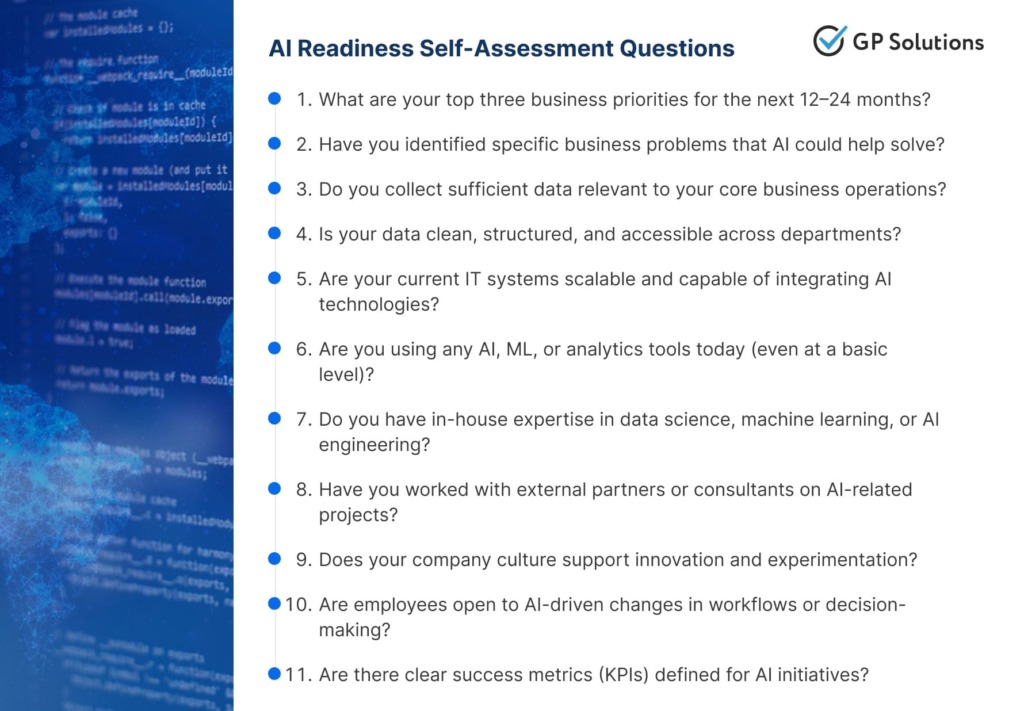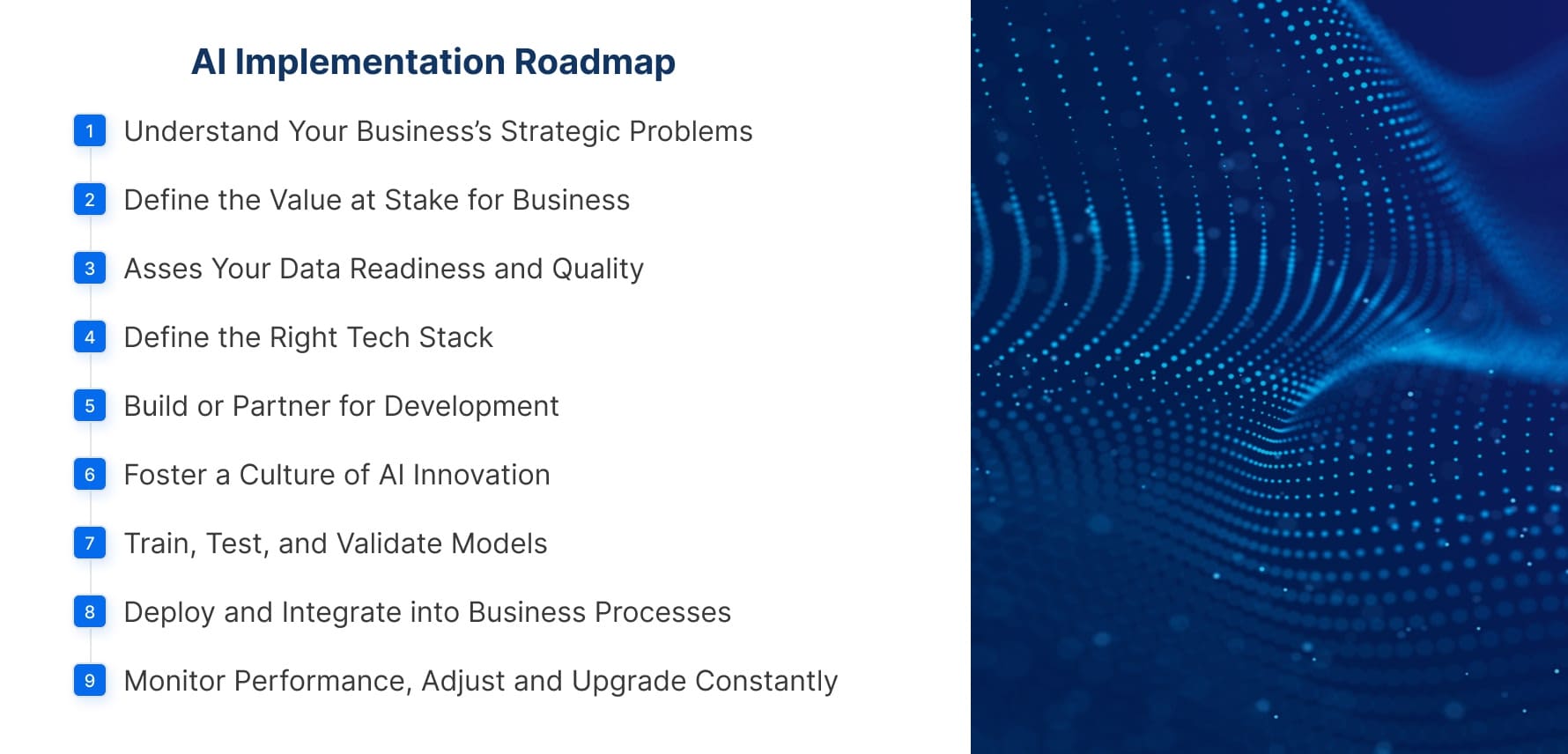Custom AI solutions have propelled us to a new business and technology paradigm. In 2025, given the immense potential and the widest scope of tasks technology can perform while outperforming humans in speed and oftentimes in quality, the pressure to innovate using AI is higher than ever. The numbers speak for themselves: the global AI market is projected to reach US$244.22 billion this year and is set to grow at a staggering 26.60% CAGR, crossing the US$1 trillion mark by 2031.
The evolution may be rapid, but many C-level executives have their hesitations. AI-driven technology is complex, it often comes with high costs, and outcomes remain unclear, which leads to analysis paralysis or superficial adoption. It’s a common case when businesses start with generic, off-the-shelf AI tools — and although such solutions are convenient and can deliver initial value, at the end of the day they fail to create truly competitive differentiation, since many businesses can use the same tools.
That’s where custom AI solutions step in. They are built with the mission to process your data, address your particular workflows, and hit objectives you set. And there’s how AI can unfold its full potential to solve problems your competitors can’t. But where do you start? What does a strong AI strategy look like in 2025?
This article is here to demystify the process. We’ll get you through major benefits of AI custom solutions, questions you should answer before getting on an AI-driven train, common pitfalls towards AI-friendly corporate culture, and a step-by-step guide to help you design the right AI strategy. Read on to strategize for a technology many don’t fully understand.

We understand custom AI development is no easy task. Let us make it simpler for you!
Business Value — Key AI-Powered Benefits
AI goes far beyond technical upgrades — this technology can revamp how your company operates and competes. If approached wisely, you’ll get not only basic automation everyone’s after but a full spectrum of advantages for your particular case. Here’s a brief look at the major advantages you can expect from AI for your business in 2025:
Increased Efficiency and Automation
AI is especially great at automating repetitive, rule-based tasks across a company’s departments — from finance and HR to customer support and supply chain management. You not only get the job done with less human error but also free up your employees to switch to higher-value work. Take the case of KPMG, for instance. The company uses Microsoft AI to launch a team member onboarding agent. The software counsels new hires and provides templates and historical references, accelerating the onboarding process and decreasing follow-up calls by around 20%.
Do not forget about the accelerating adoption of AI-powered robots. You can check the video below to learn why tech giants invest in humanoid assistants.
Why Tech Giants Are Betting on AI Robots

Data-Driven Decision-Making
With the latest machine learning models and analytics platforms, you can take the reins of your data to make decisions faster and, more importantly, smarter. You’ll be able to get insights that would be challenging or nearly impossible to retrieve manually, e.g., data on consumer behavior or operational inefficiencies. Amadeus, one of the world’s leading GDSs, extended the capabilities of its team with Microsoft 365 Copilot. The solution makes summaries of email threads, chats, or transcripts and sums up data from multiple sources, enabling the employees to concentrate on value-added tasks.
Enhanced Customer Experience
An AI solution, e.g., an AI chatbot, can contribute to hyper-personalized experiences through tailored recommendations and proactive customer support. And where there are more satisfied clients, there will be more loyalty and willingness to spend more money for your services or products.
Cost Reduction
AI-driven automation and optimization will inevitably reduce the need for manual interventions and improve resource allocation. As a result, more budget will be spent efficiently, reducing the overall overhead.
New Revenue Streams
Artificial intelligence works not only with what it has but also with what you may have, opening the door to new sales channels and new products. Thus, for example, YouTube is going to employ Gemini to place advertisements in its videos at “contextually relevant” moments when there is the highest chance of maximum customer engagement.
Predictive Insights
Artificial intelligence can become your crystal ball and forecast customer demand, detect equipment failures beforehand, or predict fraud. This will enhance planning and reduce risk across the board.
No matter how compelling these benefits may seem, you cannot achieve them without the right strategy in place, which should be adjusted to your company’s mission, goals, and challenges. In the next chapters, we’ll show you how to build one.
Pre-Built vs. AI Custom Solutions — Choosing the Right Fit
When a company’s manager sets their mind on introducing AI into their business, they have basically two ways: to use pre-built AI-powered software or get custom AI business solutions. Either way comes with its pros and cons, limitations, and preferable use cases. Which way to go will depend on your strategic goals, technical capacity, long-term vision, and, let’s be honest, your budget.
Here’s a side-by-side comparison to help you out with your decision:
| Criteria | Pre-Built AI Solutions | Custom AI Solutions |
| Flexibility | Limited — intended for general use cases | High — made intentionally for your business-specific needs, processes, and data |
| Scalability | Moderate — platform may pose limitations on scalability | High — can be developed to scale alongside your business |
| Integration Complexity | Low — mostly plug-and-play with standard systems | Medium to High — may require integration with proprietary systems or databases |
| Cost | Lower — pay-as-you-go or subscription-based pricing | Higher — requires investment in development, configuration, and talent |
| Time to Implement | Fast — can be deployed within days or weeks | Variable — configuration may take weeks; building from scratch may take months |
| Long-Term Value | Moderate — may lose competitive edge as widely adopted | High — can evolve with your business and deliver lasting differentiation |
| Examples | AWS Comprehend, Google Dialogflow, Microsoft Azure AI tools | Custom CRM recommendation engine, AI diagnostic tools, predictive maintenance systems |
Two Approaches to Custom AI Solutions for Businesses
If you choose to go the custom way, you still have two major options to choose from:
- You can configure existing solutions: Your developer team can modify an off-the-shelf AI tool to go hand in hand with your business needs (e.g., customizing a retail inventory system to account for local demand patterns).
- You can always develop from scratch: Building a fully bespoke AI solution tailored to your business’s exact specifications (e.g., an AI tool for healthcare diagnostics based on proprietary patient data) is a tough challenge, yet in the end it will be the most fine-tuned AI software you can imagine.
The right choice depends on how far you want to go — and how special your requirements really are.

Unlike generic tools, custom AI business solutions can bolster your competitive differentiation because they can tailor their functionality to the challenges inherent to a particular industry — fraud detection in finance, predictive maintenance in the automotive industry, patient diagnostics in healthcare, or automated assignment scoring in education.
Over time, your business will benefit from improved ROI as AI custom solutions evolve with your needs via scalable architectures. Additionally, processing proprietary data within a secure, custom environment ensures a proprietary advantage and greater control over data privacy and compliance — crucial in highly regulated sectors and against today’s cybercrime advancements.
When to Invest in Custom AI Solutions for Businesses?
Deciding when to invest in custom AI solutions is no less important than knowing where to start. For many, the crucial moment emerges when traditional software cannot handle business complexity, data volumes, or pressure against competitors’ advancements. If you happen to spot this moment in the bud, you will make it to the first stage of your AI implementation journey much faster and more consciously.
Below, we list clear indicators that your company is ready to take on more AI:
- Operational Inefficiencies: Repetitive tasks, manual operations, or legacy systems are slowing you down. AI can free up human resources for higher-value work.
- Massive or Complex Data Volumes: Off-the-shelf software solutions are often just not enough for businesses that handle large, diverse data on a daily basis and especially in real-time (supply chain logistics, financial markets, or IoT). Custom works way better with the precision and speed required.
- Customer Service Gaps: Your basic generative AI solutions or FAQ chatbot no longer meet customer expectations.
- Forecasting and Real-Time Decision-Making Needs: You need more accurate demand forecasts, predictive maintenance, or dynamic pricing models that will align with your operational context and data inputs.
- Special Industry Requirements: Legal, healthcare, manufacturing, and other highly regulated or specialized sectors often face challenges that ready AI can’t handle — like domain-specific language processing or compliance-sensitive data handling.
In this video, you can check the latest AI developments in the manufacturing sector, famous for its complexity and high need for smart automation.
The Rise of AI in Factories

Early-stage companies may draw advantages from plug-and-play solutions, but as they grow, the transition to custom AI solutions becomes the next logical step. When you scale and have to transform digitally to reach new markets, AI readiness becomes an inherent part of your maturity model. Indicators of such readiness include a robust data infrastructure, clearly defined KPIs, and a leadership team collaborating on innovation goals.
We have prepared a quick questionnaire to help you assess your current capabilities, identify potential opportunities, and uncover gaps. Try answering these questions, and you’ll gain a clearer understanding of whether AI is the right next step.

Common Challenges in AI Implementation
AI custom solutions can pave you the way towards the future, but this way won’t unfold without challenges. We invite you to examine the barriers many organizations face in their AI initiatives. Study them carefully, because the earlier you handle them, the lower your chances that your AI plans will be delayed or, worse, derailed.
Data Silos and Poor-Quality Data
The success of AI-powered systems, even the smallest, like an AI chatbot, lies in how clean and integrated your datasets are. As a software vendor, we observed many clients who still have a hard time with fragmented or inconsistent data sources. Failing data governance or legacy infrastructure can impact model accuracy and reliability.
We will discuss how to make your data clean and structured later in the article.
Lack of Strategic Clarity
Sometimes, a company may invest in custom AI solutions due to the pressure from the competitive field or trying to catch the latest hype wave and look “modern.” But without a clear AI strategy, explicitly stating why you need AI-driven software, how it contributes to your business goals, and which results it should deliver, chances are your investment will go to waste.
Talent Shortages
Obviously, AI talent (data scientists, ML engineers, AI ethicists, and similar) is in high demand. If your in-house expertise is limited or if you struggle to recruit top talent, you may drastically fall behind schedule along your delivery pipeline. Time is of the essence here, as technology develops at an unprecedented speed, and prolonged timelines or heavy dependence on third-party consultants may jeopardize your entire project.
Ethical and Regulatory Concerns
Custom AI business solutions must operate within strict ethical and regulatory frameworks, especially in industries like finance, healthcare, and public services. Should you fail to timely address bias, data privacy, and transparency concerns, your AI-driven project can be stalled.
Integration Complexities
In the many years we have been engaged in enterprise software development, we saw multiple cases when advanced systems failed or struggled through the integration with our clients’ legacy IT infrastructure. It may be the case that before investing in custom AI solutions, it is worth considering upgrading your core software.
Resistance to Change
Employee skepticism or fear of job displacement can lead to resistance during AI adoption. Without proper change management, staff may underuse or even reject new systems.

The implementation of custom AI solutions is not an easy path, as it requires not only the right tech stack but also the right organizational culture, talent, and infrastructure. If you deal with common challenges head-on, you will lay a healthy foundation for proceeding from experiments to measured success brought by neural networks.
Our Replicable Plan for Building Custom AI Solutions
Although each company’s AI journey is unique, virtually all of them share similar core steps that are fundamental if you aim to get effective outcomes. Study our step-by-step guide that fits any use case or industry and can aid you in navigating the intricacies of AI adoption.

Step 1: Understand Your Strategic Problems and Mission Objectives
If you wish to avoid wasted investment and deliver meaningful results, do not proceed with AI before you get a clear answer to why you need custom AI solutions in the first place. The initial step in any strategy is to deeply scrutinize the business problem — or opportunity — that technology (in this case, AI) should address. As Einstein prudently said, “If I had only one hour to save the world, I would spend fifty-five minutes defining the problem, and only five minutes finding the solution.”
We recommend companies begin by checking their core operations — be it marketing, finance, or customer service — for issues and untapped potential. Ask yourself: Why are decisions being delayed, and where does it occur most? Can I enhance our interactions with customers with an AI chatbot? What should I automate first? If you align your AI strategy with the actual business drivers, the technology will fulfill its strategic purpose, and won’t become a tech solution in search of a problem.
After you have identified your primary challenges, translate them into measurable objectives. Is the goal to reduce operating costs by a fixed percentage? Or to improve customer satisfaction scores? This will provide you direction and focus and align business needs and technological advancements.
Step 2: Ensure Data Readiness and Quality
Custom AI business solutions are only as good as the data you feed them with. Even the most advanced AI models fail when processing inconsistent or flawed data, which generates unreliable outcomes and biased decisions. Your data should be accurate, up to date, and relevant to the problems you’re solving.
Start with identifying relevant data sources across your organization. These can include:
- CRM systems
- Customer interactions (e.g., support tickets, feedback)
- Operational metrics
- Sales and marketing data
- Third-party datasets
Data Collection Methods
Collecting high-quality data requires a strategic approach. Common methods include:
- Crowdsourcing: Gathering data from large groups via platforms like Amazon Mechanical Turk
- Existing Datasets: Utilizing publicly available datasets useful in areas such as image recognition or language processing
- Web Scraping: Extracting large volumes of structured data from websites using specialized tools
- Surveys and Polls: Collecting custom data directly from users or customers
By combining diverse sources, businesses can build comprehensive datasets that enrich AI training.
Data Preparation
Raw data often contains errors or inconsistencies that can affect model accuracy. Preparation tasks typically involve:
- Cleaning: Removing duplicates, handling missing values, and correcting inconsistencies
- Normalization: Scaling numerical data to a consistent range for efficient model learning
- Splitting: Dividing data into training, validation, and testing sets to ensure proper model evaluation
- Labeling/Annotation: For supervised learning tasks, tagging data (e.g., marking images as “defective” or “non-defective”) is essential
Additional Considerations
- Ensure data is stored in machine-readable, structured formats
- Comply with relevant privacy regulations to protect sensitive information
- Standardize and integrate data across different departments or systems to enable seamless accessibility
- Establish robust data pipelines and storage solutions to support scalable AI deployment
Step 3. Define the Right Tech Stack
Once you have clearly defined your operational and business objectives and got the required data in place, it’s time to turn to the software part of things and choose the right tech stack for your custom AI business solutions. You will need to match technologies to your specific case — for instance, whether you go for generative AI solutions, predictive modeling, or computer vision.
Cloud platforms such as AWS SageMaker, Google Cloud Vertex AI, and Microsoft Azure Machine Learning are great at providing developers with scalable infrastructure to train, deploy, and manage models forming the base of your AI-powered system. You will mostly appreciate these services, if you lack on-premises resources, but you want to stay flexible and powerful at scale.
If we turn to AI development as such, AI engineers tend to choose open-source frameworks like TensorFlow, PyTorch, Scikit-learn, and Keras which are especially resourceful for ML and DL. They can cut down development and retain customization and experimentation functionality at the same time.
In addition, see to that your AI architecture is capable of supporting data integration, security, scalability, and team collaboration.
Step 4. Build or Partner for Development
After you know your “when to build”, it’s time to decide “how to build” your custom AI solutions. Basically, you’ve got two ways — develop in-house or partner with third-party experts through outsourcing. In-house is great, no doubts, as you obtain full control over the project while your team builds expertise. However, it comes at a cost — you need significant resources and skilled professionals. The outsourcing model, on the other hand, delivers you this specialized AI talent faster and cost-efficiently. Such cooperation may take place with several AI engineers from your software vendor or via a dedicated team of developers extended with any necessary specialist that is required on the project.
To explore the pros and cons of in-house development versus outsourcing in more detail, check out our separate article comparing these approaches.
Step 5. Foster a Culture of AI Innovation
AI custom solutions alone cannot transform your business from top to bottom. They should be supported by an AI-driven culture throughout your organization, with IT, data science, operations, and business teams engaged strongly engaged in collaboration and communication with one another. As your company’s leader, you should foster creativity, openness, and curiosity surrounding your AI vision. It is a good practice to launch pilot projects for low-risk testing and refinement. This way, you’ll build a reliable workforce ready to hop on your journey towards digital transformation.
Step 6. Train, Test, and Validate
At first, you or your development company should test the prototype for weaknesses to minimize the possibility of post-deployment failures. The AI model then passes through the stage of extensive training, when precise data is fed to it so that you could get desired outcomes and patterns. As our experience shows, it may require several revisions.
After the training is over, the model is fed with new real-time or dummy data when you can assess its accuracy and spot any adjustments. At this stage, it is of utmost importance to ensure the model is transparent and unbiased to fit in real-world scenarios. It is recommended to use KPIs like accuracy, precision, recall, and F1 score, along with bias detection.
Working with custom AI business solutions require ongoing evaluation and retraining as your data and growth needs evolve. This approach accompanied by continuous monitoring and automated alerts helps your AI software remain reliable and valuable.
Step 7. Deploy and Integrate into Business Processes
Deploying custom AI solutions isn’t merely flipping a switch. At this stage, you must ensure AI seamlessly integrates within your existing infrastructure when you connect it to internal systems, often via APIs. Compliance checks are a must, especially when processing sensitive information, that is why one have to adhere to data privacy regulations like GDPR or CCPA. In scenarios involving ultra-low latency, for instance, with autonomous systems or real-time monitoring, pay attention to edge computing that can deploy models directly to devices.
Step 8. Monitor Performance and Update Constantly
However, your journey doesn’t end there. Custom AI business solutions can degrade over time due to shifting data patterns, a phenomenon known as “concept drift”. Continuous monitoring and maintenance become your helping hands in keeping your models relevant and performing. Implement intuitive dashboards to keep track of KPIs, and you’ll be able to proactively identify accuracy decline. Another practice is to retrain pipelines with fresh data and feedback loops with user insights.
Your AI custom solutions should be scalable. As you notice data volumes and user bases expanding, make sure your system can adapt to these changes without harming performance.
This complex iterative process guarantees sustained impact and a future-proof AI investment.
Building AI Has Never Been Easier
We are sure that this guide has proved once and again that AI implementation is not easy no matter which approach you choose. You’ve got numerous pitfalls you are most likely to encounter on your way both internally and externally, like your own employees’ resistance to change or the pressure to follow the tempo of your competitors.
With two major options readily available — off-the-shelf AI and custom AI business solutions — either way has its pros and cons. One must look at the entire picture at the moment and, more importantly, at the strategic goals one wants to achieve in the future, both short- and long-term.
According to McKinsey, over 50% of companies now integrate AI into at least one business function, spanning from customer service to operations, marketing, and finance. You either adapt to the new reality, or it will crush you eventually.


















